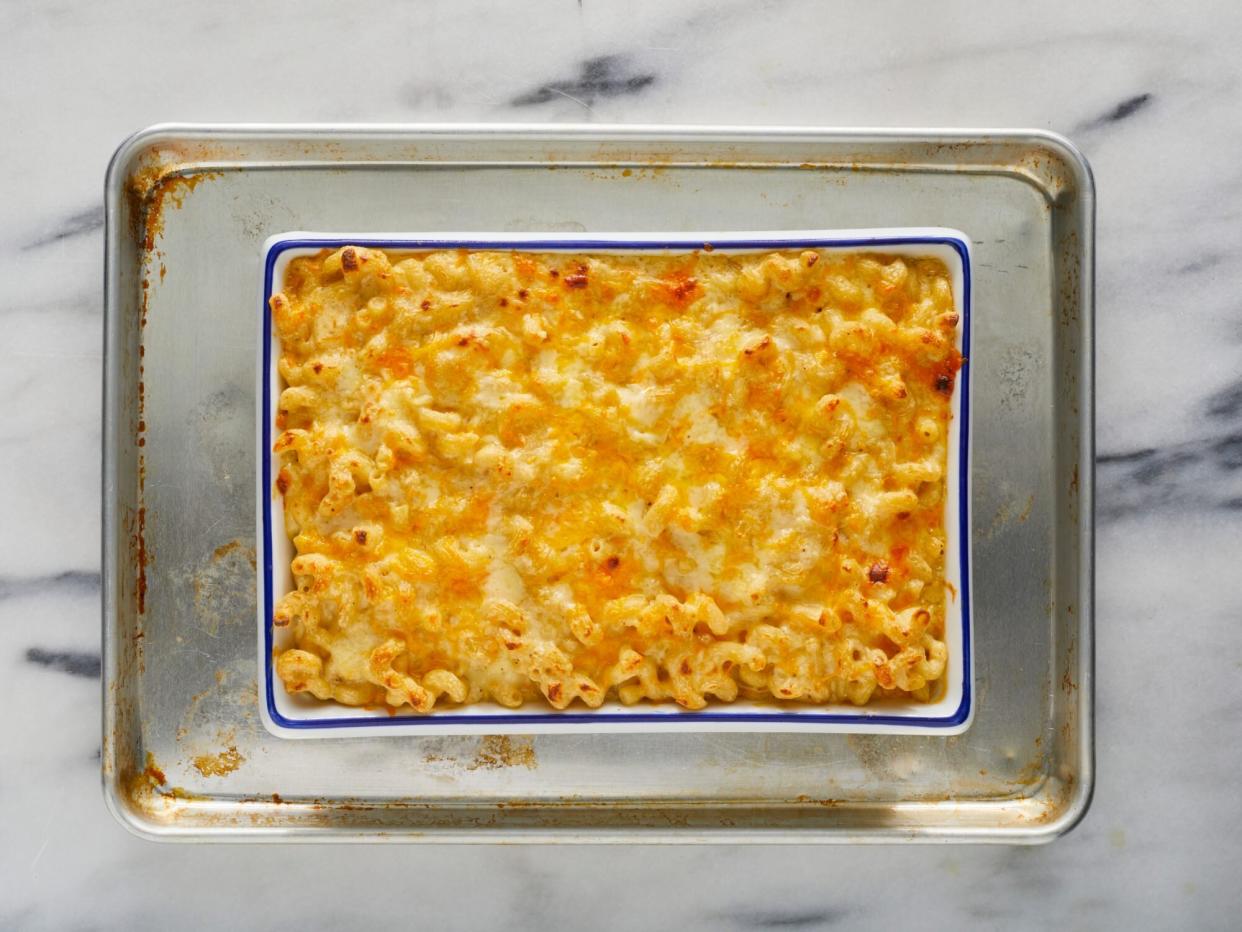Why Your Macaroni And Cheese Is Dry And How To Avoid It

Photographer: Stacy K. Allen. Food Stylist: Ruth Blackburn, Prop Stylist: Christina Daley
Macaroni and cheese is a thing of beauty when done correctly. Gooey, cheesy, saucy, and perfectly salty, it's the ultimate Thanksgiving side. It can be fancied up with all sorts of mix-ins, from andouille sausage to broccoli, or kept classic and feel just as decadent. That doesn't mean that macaroni and cheese can't be flawed. Perhaps the worst outcome is when it turns out dry. Whether it wasn't saucy enough before baking or you added too much flour on the stovetop, there's not much you can do save the dish after it comes out dry. So avoid these common mistakes and all your future macaroni and cheese adventures should be just fine.
How To Keep Macaroni And Cheese From Drying Out
There are a few different ways to keep your macaroni and cheese moist, from adding a solid layer of shredded cheese on top to holding back on the cream when making your sauce.
Add more cheese
That final layer of cheese on top isn't just for looks, it also helps keep the saucy noodles underneath from drying out during baking. Breadcrumbs also help insulate the noodles, acting as a protective layer while baking that also happens to add a nice little crunch.
Pro Tip: Don't use pre-shredded cheese. Many store-bought shredded cheese brands coat their cheese with an anti-caking agent than can make sauces grainy and less creamy. While it requires a bit of an arm workout, grating your own yields the best texture. If you don't have the time, look for grated cheeses at the store labeled "Farmstyle shredded cheese." This thicker cut cheese melts better than the super finely shredded stuff.
Use the right kind of cheese
Another thing to consider is the kinds of cheese you are using. A blend of cheese tends to balance flavor and melting qualities. Try not to use too much of the grated hard cheeses like pecorino Romano or Parmesan. A little of either is great for flavor, but too much and the sauce can become grainy and dry.
Add more sauce
When it comes to macaroni and cheese there is a fine balance between soupy and dry. It all comes down to the sauce. Remember that the noodles for macaroni and cheese are not entirely cooked when they hit the baking dish, so they will continue to cook and absorb sauce while baking. Plus, the starch from the pasta will thicken the sauce as it bakes too, so you need to initially make the sauce looser than your final desired viscosity.
It's also important to not undercook your pasta too much. You want the noodles to be al dente, but undercook them too much and they will not only absorb all the sauce, but take longer to bake, and that extra time in the oven will only dry out the macaroni and cheese further.
Cut back on cream
While cream can add a lot of flavor, too much of a good thing is just that: Too much. A lot of heavy cream can create too thick of a sauce that doesn't contain enough water content to keep everything saucy. Make sure to use primarily whole milk for your cheese sauce, and if you do use cream, use it sparingly.
Use less thickener
Most macaroni and cheese recipes rely on a roux to thicken the sauce. You want equal amounts of butter and flour by weight. This is key. Throw in too much flour, and sure the sauce might get thick, but it also might taste floury and be lumpy.
Even if you get the roux right, use too much or reduce your sauce down too far, and the macaroni and cheese will turn out dry. Remember, the sauce will tighten up in the oven, so you really only need to thicken it slightly on the stovetop.
Side Note: Unlike its baked counterpart, stovetop macaroni and cheese is much easier to fix when too dry. If it looks too thick on the stovetop, splash in a few tablespoons of milk while still on the heat. Be careful to add a little at a time to avoid loosening the sauce too much or splitting it.
A Note On Make-Ahead Macaroni And Cheese
Baked macaroni and cheese is best served hot, 10-15 minutes after baking. As it cools it will thicken and dry slightly, and reheating can be a bit of a nightmare. When it comes to making the dish ahead of time, whether for a potluck or holiday entertaining, we don't recommend baking it off a day ahead. Instead, use our Classic Make-Ahead Macaroni and Cheese recipe that allows you to assemble the entire dish the day before, then bake and serve it fresh out of the oven the next day.
How To Save Dry Macaroni and Cheese
If we're being honest, you can't really save macaroni and cheese if it's already been baked and turns out dry. It's hard to incorporate more liquid after baking, especially when you've already topped the dish with a breadcrumb topping. We suggest repurposing the macaroni and cheese with our Fried Mac and Cheese Bites. Just chill the dry macaroni and cheese until firm (at least 3 hours), then scoop, dredge, and fry. The finger food can be served as a fun appetizer while the rest of Christmas dinner comes together. It's not the classic side you know and love, but deep-fried and dipped in a flavorful sauce, it will taste better than dry macaroni and cheese any day.
